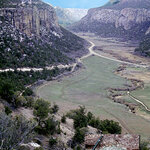Geology

Geoscientists have long presumed that the tropics remained warm throughout Earth's last major glaciation 300 million years ago but new evidence indicates that cold temperatures episodically gripped even equatorial latitudes at that time.
Geologist Gerilyn Soreghan of Oklahoma University found evidence for this conclusion in the preservation of an ancient glacial landscape in the Rocky Mountains of western Colorado. Three hundred million years ago, the region was part of the tropics. The continents then were assembled into the supercontinent Pangaea.
Climate model simulations are unable to…

Mars once hosted vast lakes, flowing rivers and a variety of other wet environments that had the potential to support life, according to two new studies based on data from the Compact Reconnaissance Imaging Spectrometer for Mars (CRISM) and other instruments on board NASA's Mars Reconnaissance Orbiter (MRO).
"The big surprise from these new results is how pervasive and long-lasting Mars' water was, and how diverse the wet environments were," says Scott Murchie, CRISM's principal investigator at the Johns Hopkins University Applied Physics Laboratory (APL), in Laurel, Md.
This three-…

The Tunguska event is regarded as one of the biggest natural disasters of modern times. On 30 June 1908 one or more explosions took place in the area close to the Tunguska River north of Lake Baikal. The explosion(s) flattened around 80 million trees over an area of more than 2000 square kilometres.
The strength of the explosion is estimated to have been equivalent to between five and 30 megatons of TNT. That is more than a thousand times as powerful as the Hiroshima bomb.
This almost unpopulated region of Siberia was first studied in 1927 by Professor Leonid A. Kulik. There are a number of…

For the first time, researchers have taken a detailed look at what lies beneath all of Iceland's volcanoes – and found a world far more complex than they ever imagined.
They mapped an elaborate maze of magma chambers - work that could one day help scientists better understand how earthquakes and volcanic eruptions occur in Iceland and elsewhere in the world.
Knowing where magma chambers are located is a key first step to understanding the chemical composition of the molten rock that is flowing within them - and of the gases that are released when a volcano erupts, explained Daniel Kelley,…

Meteorites are a major tool for knowing the history of the solar system because their composition is a record of past geologic processes that occurred while they were still incorporated in the parent asteroid.
Most of the meteorites that we collect on Earth come from the main belt of asteroids located between Mars and Jupiter [1]. They were ejected from their asteroidal "parent body" after a collision, were injected into a new orbit, and they finally felt onto the Earth.
One fundamental difficulty is that we do not know exactly where the majority of meteorite specimens come from within the…

A research team has for the first time discovered evidence of water that came from deep within the Moon, a revelation that strongly suggests water has been a part of the Moon since its early existence – and perhaps ever since it was created by a cataclysmic collision between the early Earth and a Mars-sized object about 4.5 billion years ago.
The team, led by Alberto Saal, assistant professor of geological sciences at Brown, believes that the water was contained in magmas erupted from fire fountains onto the surface of the Moon more than 3 billion years ago. About 95 percent of the water…

In a recent paper, geophysicist Mioara Mandea from the GFZ German Research Centre for Geosciences, Potsdam and her Danish colleague Nils OLSEN from the National Space Institute/DTU Copenhagen, have shown that motions in the fluid in the Earth’s core are changing surprisingly fast, and that this, in turn, effects the magnetic field of our planet.
The very precise measurements of the Earth’s magnetic field delivered by the geosatellite CHAMP combined with Ørsted satellite data and ground observations over the past nine years, have made it possible to reveal what is happening at 3,000 km under…

The world of geology changes rapidly - sometimes the Grand Canyon is one age and then it is found to be much older. But even in geology it's not often a date gets revised by 500 million years.
University of Florida geologists say they have evidence that a half-dozen major basins in India were formed a billion or more years ago, making them at least 500 million years older than commonly thought. If so, it might remove one of the major obstacles to the 'Snowball Earth' theory that says a frozen Earth was once entirely covered in snow and ice. It might even lend some weight to a controversial…

Scientists have long anguished over how little is known about Mercury, the innermost of the four terrestrial planetary bodies in our solar system. The gaps in knowledge covered such basic information as the planet's geology, how it was formed and evolved and whether its interior was still active.
In 1975, the Mariner 10 spacecraft returned intriguing images that showed smooth plains covering large swaths of Mercury's surface. But scientists could not determine whether the plains had been created by volcanic activity or by material ejected from below the surface when objects had collided into…

An international team of researchers says they have evidence of explosive volcanism in the deeps of the ice-covered Arctic Ocean for the first time.
Researchers from an expedition to the Gakkel Ridge report in the current issue of Nature that they discovered extensive layers of volcanic ash on the seafloor, which indicates a gigantic volcanic eruption.
A major part of Earth's volcanism happens at the so-called mid-ocean ridges and, therefore, completely undetected on the seafloor. There, the continental plates drift apart; liquid magma intrudes into the gap and constantly forms new seafloor…